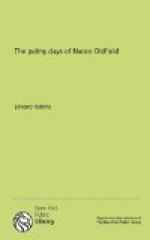[Footnote A: This essay was written (July, 1709) at the time that Drury Lane was closed, by order of the Lord Chamberlain.]
THE INVENTORY.
Spirits of right Nantz brandy, for lambent flames and apparitions.
Three bottles and a half of lightning.
One shower of snow in the whitest French paper.
Two showers of a browner sort.
A sea, consisting of a dozen large waves; the tenth bigger than ordinary, and a little damaged.
A dozen and a half of clouds, trimmed with black, and well conditioned.
A rainbow, a little faded.
A set of clouds after the French mode, streaked with lightning and furbelowed.
A new moon, something decayed.
A pint of the finest Spanish wash, being all that is left of two hogsheads sent over last winter.
A coach very finely gilt, and little used, with a pair of dragons, to be sold cheap.
A setting-sun, a pennyworth.
An imperial mantle, made for Cyrus the Great, and
worn by Julius
Caesar, Bajazet, King Harry the Eighth, and Signor
Valentini.
A basket-hilted sword, very convenient to carry milk in.
Roxana’s night-gown.
Othello’s handkerchief.
The imperial robes of Xerxes, never worn but once.
A wild boar killed by Mrs. Tofts[A] and Dioclesian.
[Footnote A: A favourite singer of the day.]
A serpent to sting Cleopatra.
A mustard-bowl to make thunder with.
Another of a bigger sort, by Mr. D——’s[A] directions, little used.
[Footnote A: John Dennis, the critic.]
Six elbow-chairs, very expert in country dances, with six flower-pots for their partners.
The whiskers of a Turkish Pasha.
The complexion of a murderer in a band-box; consisting of a large piece of burnt cork, and a coal-black peruke.
A suit of clothes for a ghost, viz., a bloody shirt, a doublet curiously pinked, and a coat with three great eyelet-holes upon the breast.
A bale of red Spanish wool.
Modern plots, commonly known by the name of trapdoors, ladders of ropes, vizard-masques, and tables with broad carpets over them.
Three oak-cudgels, with one of crab-tree; all bought
for the use of
Mr. Pinkethman.[A]
[Footnote A: The comedian.]
Materials for dancing; as masques, castanets, and a ladder of ten rounds.
Aurengezebe’s scymitar, made by Will Brown in Piccadilly.
A plume of feathers, never used but by Oedipus and the Earl of Essex.
There are also swords, halbards, sheep-hooks, cardinals’ hats, turbans, drums, gallipots, a gibbet, a cradle, a rack, a cart-wheel, an altar, an helmet, a back-piece, a breast-plate, a bell, a tub, and a jointed baby.




